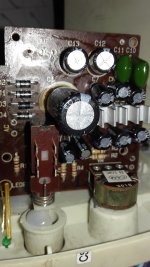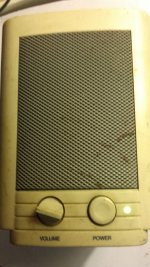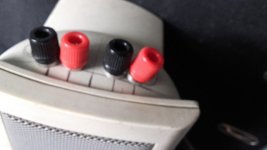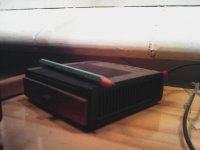Low watt amplifiers are capable of driving large speakers. Experiments with a PC speaker amp connected to 6" woofers showed acceptable volume. Distortion and component damage is a concern, though.
My project is to re-use the electronics from a used PC speaker that would probably be thrown away. I will be using an external power adapter instead of the AC in which is for 110 volts. A suitable enclosure will complete the project.
Something along these lines here:

My project is to re-use the electronics from a used PC speaker that would probably be thrown away. I will be using an external power adapter instead of the AC in which is for 110 volts. A suitable enclosure will complete the project.
Something along these lines here:
First step is to open up the set of speakers. The set I tried was difficult to open up, so I tried another pair that I used for testing earlier.
I originally thought of connecting an external power supply to supply dc current to the amplifier circuit. Like it says in the article I quoted, this is for safety. I did not feel safe allowing 220 Volts AC current into the unit I was going to be working on. On opening up the unit, however, I saw that the transformer was connected to the board and marked "AC" : there were four electronic components just next to the AC input : I guessed they were diodes to rectify the AC current to DC.
Looks like I will stay with the original amplified speaker enclosure this time.
I originally thought of connecting an external power supply to supply dc current to the amplifier circuit. Like it says in the article I quoted, this is for safety. I did not feel safe allowing 220 Volts AC current into the unit I was going to be working on. On opening up the unit, however, I saw that the transformer was connected to the board and marked "AC" : there were four electronic components just next to the AC input : I guessed they were diodes to rectify the AC current to DC.
Looks like I will stay with the original amplified speaker enclosure this time.
The only way for doin' itFirst step is to open up the set of speakers. The set I tried was difficult to open up, so I tried another pair that I used for testing earlier.

Yap! The secondary ( winding) of the transformer provides the necessary low voltage ISOLATED from the mains ( GAlvanic isolation )however, I saw that the transformer was connected to the board and marked "AC"
If you play with electronics, you'll often encounter one
Picture
Here is a picture of the board. If I can find the output from the rectifiers then I can connect a DC adapter to this. Otherwise stick with the original AC input and enclosure.
My low cost Amp I bought is butting out a hum and heating up the speaker drivers - at high volumes and high bass control settings, I think. Why take a chance though?
So PC speaker conversion is the plan/
Here is a picture of the board. If I can find the output from the rectifiers then I can connect a DC adapter to this. Otherwise stick with the original AC input and enclosure.
My low cost Amp I bought is butting out a hum and heating up the speaker drivers - at high volumes and high bass control settings, I think. Why take a chance though?
So PC speaker conversion is the plan/
Attachments
Tested with 8 Ohm speakers - with 8 ohm woofer and 8 ohm tweeter in parallel, and a cap for the tweeter, will it be equavalent to 4 ohms impedence? The theory says it does. The original speaker was marked 4 ohms and 2 watts.
So to the point - how will it be possible to damage this amp and /or the speakers? Once I know that I can avoid it.
Very similar thread:
http://www.diyaudio.com/forums/power-supplies/129238-better-transformer-very-little-amp-project.html
So to the point - how will it be possible to damage this amp and /or the speakers? Once I know that I can avoid it.
Very similar thread:
http://www.diyaudio.com/forums/power-supplies/129238-better-transformer-very-little-amp-project.html
Last edited:
Theory says that loudspeakers are complex loads and therefore cannot be assimilated to resistances.
The fact is that low power chip amps ( low is < 10 W ) show an increase of distortion above their average power which is rather unacceptable.
The fact that they are so diffused is because often there's a more powerful subwoofer ( often the same chip but in BTL mode ) that provides the so-called ooomph
Music contains peaks which are the most demanding in terms of current and driving for the speakers, so those are where the limits of the system is shown.
*music* is not sitting in front of the computer listening to YT from 1/2 m with speakers placed on the desk
The fact is that low power chip amps ( low is < 10 W ) show an increase of distortion above their average power which is rather unacceptable.
The fact that they are so diffused is because often there's a more powerful subwoofer ( often the same chip but in BTL mode ) that provides the so-called ooomph
Music contains peaks which are the most demanding in terms of current and driving for the speakers, so those are where the limits of the system is shown.
*music* is not sitting in front of the computer listening to YT from 1/2 m with speakers placed on the desk
Realistic test
As a test, I connected the wires to the unpowered speaker to my set of Radio Shack speakers shown here in this project. The small powered speaker deowned out the sound of the 40-1011, so I snipped the wires to the powered speaker inside the case, and connected the wire to the said Radio Shack woofer unit.
Music, or program material was the following jazz cd: Diana Krall Live in Paris, tracks 2 and 3
What did it sound like?
Firstly it was huge improvement on the little pc speakers. It was pleasant to listen to. I could here the bass clearly in the background, something that the smaller speaker would not highlight. Guitar was full and clear, and vocals were well represented but with a boxiness that surprised me. Piano was coloured, again, seeming to be played from inside a box.
The point is that the same amp will play a better set of speakers very well, and with listenable sound quality. Remember I was testing one speaker, one woofer unit without the tweeter connected. To make things worse, the woofer in question had a damaged dome and a crack in in where a careless screwdriver pierced it a few days ago.
There is a funny tendency to cut out in the middle of the music - is it because the wires are not soldered or could this be clipping? No smoking yet though.
Volume is 50% and I get an average 80dB at 1 metre from the speaker.
As a test, I connected the wires to the unpowered speaker to my set of Radio Shack speakers shown here in this project. The small powered speaker deowned out the sound of the 40-1011, so I snipped the wires to the powered speaker inside the case, and connected the wire to the said Radio Shack woofer unit.
Music, or program material was the following jazz cd: Diana Krall Live in Paris, tracks 2 and 3
What did it sound like?
Firstly it was huge improvement on the little pc speakers. It was pleasant to listen to. I could here the bass clearly in the background, something that the smaller speaker would not highlight. Guitar was full and clear, and vocals were well represented but with a boxiness that surprised me. Piano was coloured, again, seeming to be played from inside a box.
The point is that the same amp will play a better set of speakers very well, and with listenable sound quality. Remember I was testing one speaker, one woofer unit without the tweeter connected. To make things worse, the woofer in question had a damaged dome and a crack in in where a careless screwdriver pierced it a few days ago.
There is a funny tendency to cut out in the middle of the music - is it because the wires are not soldered or could this be clipping? No smoking yet though.
Volume is 50% and I get an average 80dB at 1 metre from the speaker.
Last edited:
Another attempt to locate the soldering points for an external DC 12 volt power supply instead of the AC transformer power was not successful. There is a large capacitor near the set of 4 diodes and I am not sure what is connected to what. Better leave it as it is, and connect two speaker output terminals to the top of the box. Paint the box and then I am done. Next on to the speakers.
This instructable says to connect the battery output (9V in this case) to the AC input of the board. Will this cause any problems? I could possibly go this route with this current powered speaker amplifier project and save a lot of trouble.
Last edited:
Comlpleted PC speaker to amplifier conversion
Connected speaker outs to speaker posts on the case. Works fine. 70 dBA SPL at 1 metre.
How does it sound? Well with my speakers on another thread, I am getting a clear output using only the two 6" woofers used as open baffle.
Already it is better than any of the mini stereo systems on the market.
Connected speaker outs to speaker posts on the case. Works fine. 70 dBA SPL at 1 metre.
How does it sound? Well with my speakers on another thread, I am getting a clear output using only the two 6" woofers used as open baffle.
Already it is better than any of the mini stereo systems on the market.
Attachments
Last edited:
Apparently DC input can be supplied to the AC input terminals. In this case, the speaker can be run off DC - such as batteries or an adapter.
Power Topics for Power Supply Users: Can I Operate my AC-DC Power Supply with a DC Input?
Power Topics for Power Supply Users: Can I Operate my AC-DC Power Supply with a DC Input?
What I usually do is disassemble the unit so I can get a voltage reading at the filter cap. (Unit filleted open and plugged into the A.C. source as in normal operation) That gives me an idea of what D.C voltage I can apply..
If the unit has a full wave diode bridge, (Like the one in your example) D.C. can be applied at the connections of the original transformer with no regard to polarity. The full wave bridge make it impossible to connect the D.C. incorrectly..
If the unit has a full wave diode bridge, (Like the one in your example) D.C. can be applied at the connections of the original transformer with no regard to polarity. The full wave bridge make it impossible to connect the D.C. incorrectly..
Update: It works! A 9 volt battery powers the speakers, and it does not matter how it is connected. It also works off 3 volts. Burned out a speaker running this way - could there be a connection? (no pun intended).
All set to transfer the electronics to a sleek amplifier case, one that can be wall - mounted.
All set to transfer the electronics to a sleek amplifier case, one that can be wall - mounted.
- Home
- Amplifiers
- Chip Amps
- PC Speaker electronics to amplifier conversion



